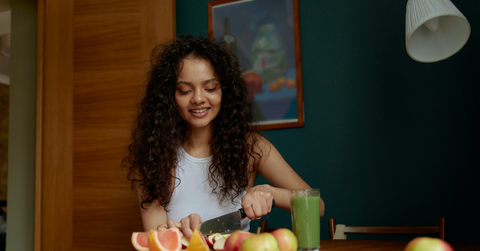5 Small Tweaks To Level Up Your Nutrition Game

About two years ago, I was struggling with my eating habits and not feeling great about it. Life was too busy to make drastic changes and I was frustrated because I felt that if I couldn’t make a big change, there wasn’t much of a point.
With the “self-care” hashtag on more than 83 million Instagram posts (and more than 4.9 billion search results on Google for “nutrition,” it can be overwhelming trying to navigate nutrition and self-care. But making meaningful changes to your nutrition doesn’t need to be difficult. What’s important is that they’re effective and sustainable because good nutrition is a lifetime practice.
If you’re looking for small sustainable tweaks to your eating habits that can easily be incorporated into your busy day, the following have worked well for me.
1. Eat vegetables and greens first.
It turns out our moms were right to encourage us to eat our vegetables. Yes, they contain essential nutrients, but research also shows that eating greens first helps regulate blood sugar and insulin levels.
What I like to do is eat my salad first during dinner. I’ve noticed that I end up eating smaller portions of protein and carbohydrates which prevents me from feeling overly full. My goal is to eat greens first every day for lunch and dinner but it’s still a work in progress; sometimes I forget!
2. Swap your sweet beverages for water.

You’ll be hard pressed to find someone who hasn’t heard the advice of drinking 8 glasses of water a day. Water is essential for healthy digestion, kidney function, oxygenation, healthy skin, and for the release of nutrients and minerals. Added bonus: it’s calorie, caffeine, and alcohol-free. But I’ll be the first to admit that it can be a challenge to meet that suggested quota.
To be better with my water intake, I keep a bottle of water in view as a physical reminder that I need to hydrate and I have stopped buying flavored beverages and juices. Just this one action has made a dramatic difference in how much water I drink each day.
3. Eat colorful.
While it’s well-known that eating fruits and vegetables is good for you, variety is key here. Plant-based foods contain phytonutrients, which research shows protect against chronic diseases like cancer and heart disease. Each color provides different benefits, so the aim is to eat the rainbow – less is not more here.
It might seem daunting to try to incorporate a rainbow of fruits and vegetables into your diet but I have found it to be relatively easy. I like to start my day with some fruit, mixed with either yogurt or oatmeal, and have gotten into the habit of reaching for fruit when I need a snack. Lunch and dinner generally includes servings of fruits and vegetables and I always use herbs when cooking proteins.
4. Enjoy desserts in smaller portions or with balance.

I’ve never been successful with diets that required cutting foods out or severely restricting how much I ate. I always ended up frustrated, craving foods I “shouldn’t” eat, and ultimately feeling like a failure.
Studies have shown that denying yourself can actually lead to overeating; your brain’s stress system is activated and that triggers anxiety and withdrawal-like symptoms. Life is stressful enough without adding food guilt!
What I like to do is split dessert with my partner after dinner instead of eating two separate desserts. I’ll have a piece of chocolate instead of half the bar or one cookie instead of four. These small indulgences satisfy the craving, prevent binging, and make me feel good.
5. Practice mindful eating.
No matter what small changes you make to your eating habits, possibly the best thing you can do is start paying attention to how you’re eating. Mindful eating allows you to slow down, enjoy the experience of having a meal, and become more aware of what you’re eating. When you’re paying attention, you tend to make better choices.
I’ll admit it was difficult for me to be mindful during meals; working as a teacher got me into the habit of eating very quickly, which meant I was often overeating. After leaving the classroom, I started to take my time, sitting down properly, if only for 20 minutes at first, and chewing slowly, taking a short break in between bites. It’s become a relaxing daily ritual and made me more aware of when I am satisfied so I don’t overeat.






